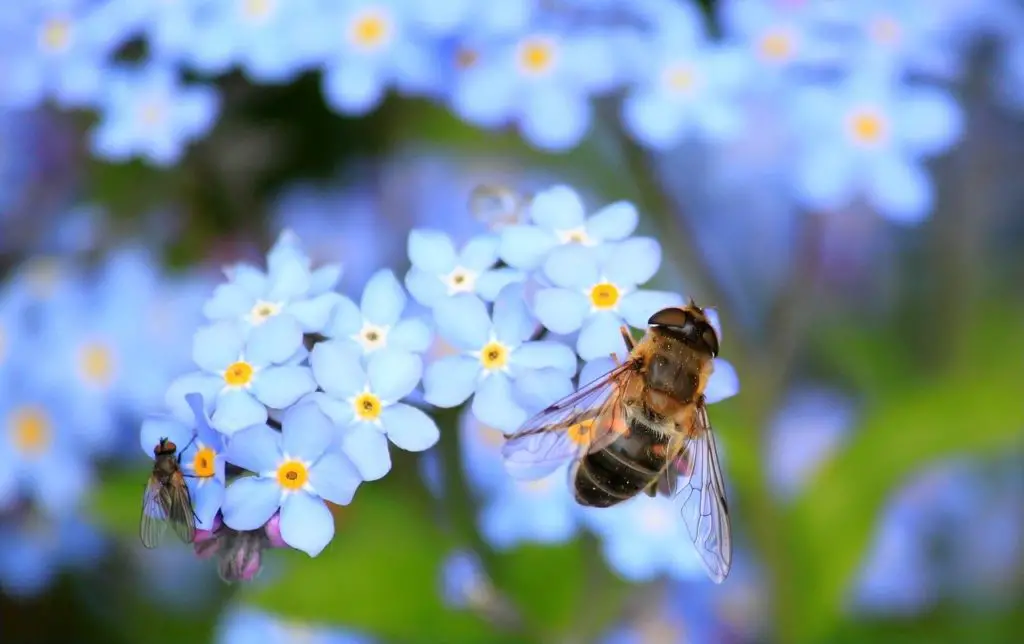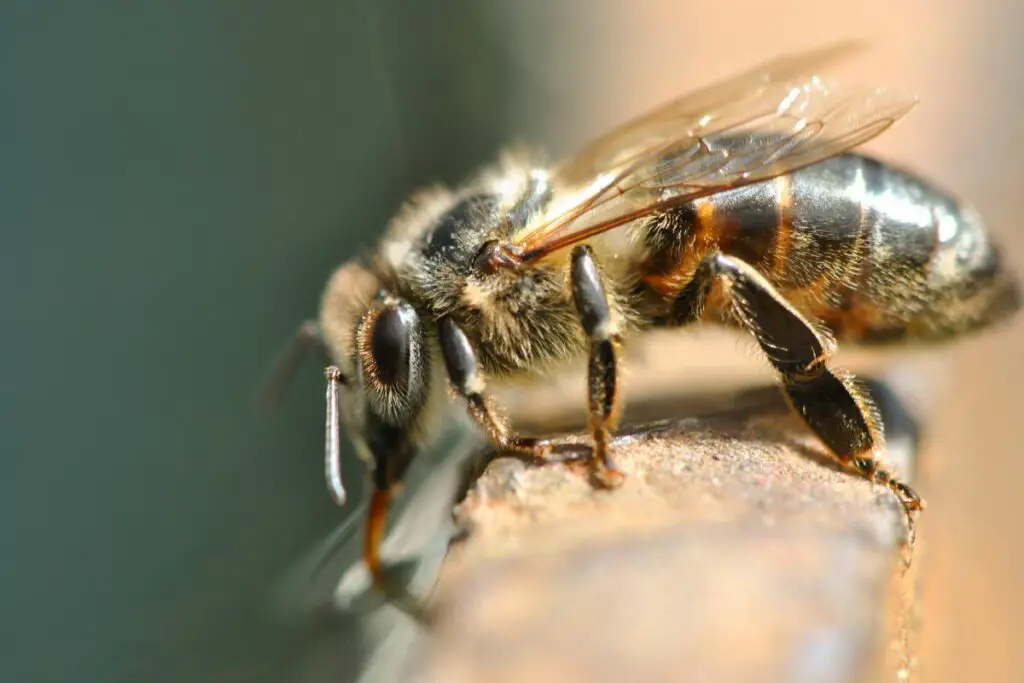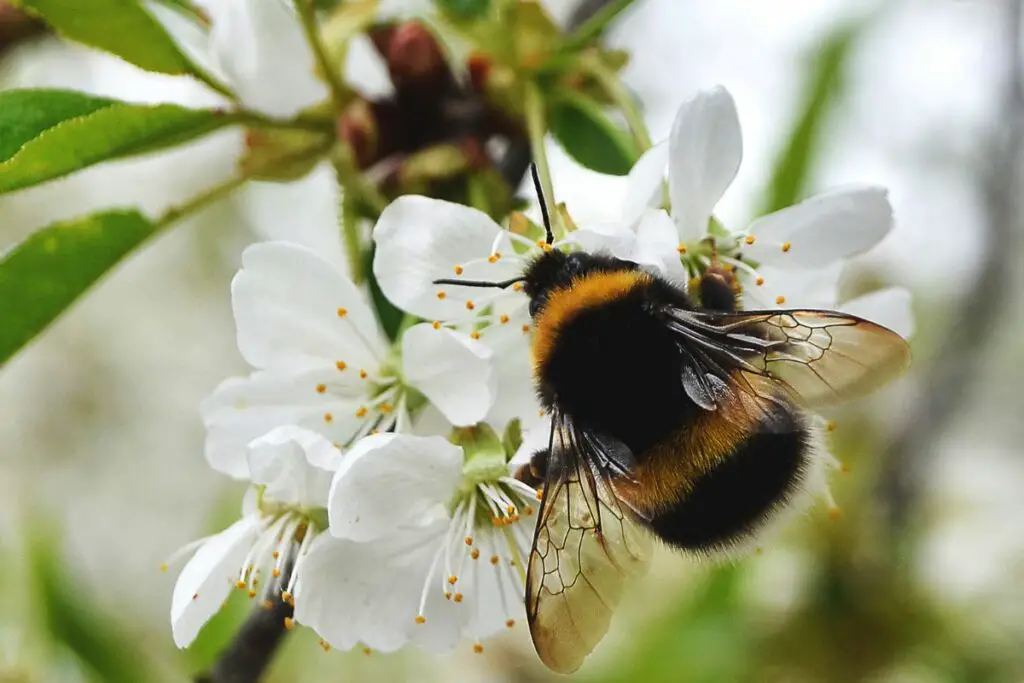Last updated on December 14th, 2023 at 05:22 pm
Here are 45 scientifically backed fascinating bee facts that might surprise you!
Number 20 could mean life or death for our tiny little friends.
- Unique Eyewitness: Bees have five eyes – two large compound eyes and three smaller ocelli eyes in the centre of their head for detecting light intensity.
- Speedy Flyers: Bees fly around 15-20 miles per hour at their fastest.
- High Altitude Flyers: They can also fly higher than Mount Everest.
- Serious Honey Money: A jar of Elvish Honey will set you back a whopping $6,886 per kg!
- Specialized Pollen Baskets: Bees have a unique basket on their hind legs to help them collect and transport pollen.
- Ancient Right: In 1215, the Magna Carta (a book of laws in medieval England) allowed common folk to keep bees. An activity previously reserved for royalty.
- Incredible Lifespan Variance: A queen bee can live up to five years, whereas a worker bee only lives for about six weeks during the busy summer months.
- Remarkable Memory: Bees have excellent spatial memory and remember the locations of hundreds of flowers to forage.
- Training Bees: Bees can be trained to associate the smell of explosives with food. In controlled environments, bees are exposed to the scent of explosives and rewarded with sugar water.
- Temperature Controllers: Bees can regulate the hive’s temperature, even creating a ‘bee heater’ effect in winter.
- Bees In Space: In 1984, bees were sent into space for a fascinating zero-gravity experiment on the space shuttle Challenger.
- Diverse Species: There are over 20,000 different species of bees worldwide.
- Male Bees – Drones: Male bees, known as drones, have no stinger and do not collect pollen or nectar.
- Vital Crop Pollinators: About one-third of our food relies directly or indirectly on bee pollination.
- Bee Revival: You can help a tired bee with a teaspoon of sugar water or our handy bee revival kit.
- Bee Bread: Inside the hive, bees create a mixture of pollen and honey known as “bee bread”, which serves as their primary source of protein.
- Wing Beat Frequency: A bee’s wings beat approximately 200 times per second.
- Medical Wonders: By exposing bees to specific odours and rewarding them, you can quickly train bees to identify several diseases that occur in humans.
- Beeswax Production: Bees produce beeswax from glands on their abdomen, which are used to build honeycomb structures.
- Honey Is Bad For Bees: A teaspoon of honey is always bad for a tired, thirsty bee. Harmful bacteria and diseases from other honey can be carried back to their nest.
- Sensitive to Electricity: Bees can sense the electric fields of flowers, which helps them find pollen-rich blooms.
- Night Bees: Some bees, like the Megalopta, are nocturnal and can navigate in the dark.
- Only Female Bees Sting: Only female honey bees (worker bees and the queen) have stingers.
- Beekeeping Isn’t Always A Good Thing: Lots of domestic honey bees in an area make it hard for native solitary bees to compete for resources.
- Water Collectors: Bees also collect water to help regulate the temperature and humidity of the hive.
- Queen’s Exclusive Diet: The queen bee exclusively eats royal jelly.
- Bee Navigation: Bees use the sun as a compass to navigate, even on cloudy days.
- Hive Decision Making: When a hive becomes too crowded, bees create a new queen, and the old queen leaves with half the colony to form a new hive.
- Distinctive Personalities: Research suggests individual bees have unique personalities, with some showing more adventurous traits than others.
- Bee Venom Therapy: Bee venom has been studied for its medicinal properties, including potential treatments for arthritis and high blood pressure.
- Bee ‘Midwives’: Attendant bees help the queen during the birthing process, a fascinating behaviour in the insect world.
- Bee Navigation Skills: Bees use landmarks to navigate and can learn to recognize specific features in their environment.
- Propolis Production: Bees create a resinous substance called propolis, which has antibacterial properties and is used to seal small gaps in the hive.
- Bee Hibernation: Some species of bees, or their queens, hibernate during the winter.
- Bee Sleep Patterns: Bees sleep between five and eight hours daily and have a rapid eye movement (REM) sleep phase.
- Hygienic Behavior: Some bees exhibit hygienic behaviour by removing diseased or dead larvae from the hive, which is crucial for maintaining colony health.
- Bee ‘Pharmacists’: Bees choose specific types of nectar with medicinal properties to protect the hive’s health.
- Selective Pollination: Bees are selective pollinators, often preferring certain flowers over others.
- Bee Language Complexity: The bee waggle dance, once thought simple, is a highly sophisticated and complex form of communication.
- Bee Lifespan Factors: The lifespan of a bee can be influenced by when it hatches; winter bees live much longer than those hard-working summer bees.
- Bees and Biodiversity: Bees contribute to the maintenance of biodiversity by pollinating various plants.
- Bee Population Dynamics: Bee populations are dynamic and can fluctuate significantly yearly based on environmental conditions.
- Bee Sensory Perception: Bees have an acute sense of smell, which they use to detect nectar and pheromones.
- Bee Color Vision: Bees can see colours, but their spectrum includes more ultraviolet and less red than humans can see.
- Impact of Pesticides: Studies have shown that certain pesticides, particularly neonicotinoids, can harm bee health and behaviour.
- Bees as Bioindicators: Bees are considered bioindicators, meaning their health and behaviour can indicate broader environmental conditions.
- Bee’s Contribution to Food Security: Bees play a significant role in global food security due to their pollination services for many crops.
- Thermal Regulation in Hives: Bees actively regulate the temperature in their hive, keeping it around 95°F (35°C), which is ideal for brood-rearing.
Don’t forget to check our our other reads below packed with more fascinating looks at one of nature’s most incredible insects, the bee!





